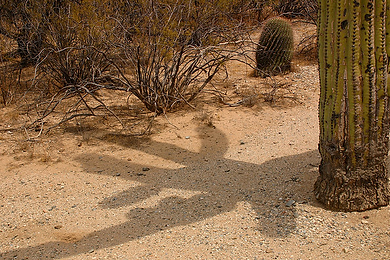
Non-Feeding Relationships
Once you visit the vast openness of the Mojave desert, beauty will take a whole new meaning. It is amazing how plants and animals that inhabit the Mojave desert are interlaced in non-feeding relationships to survive in the harsh life of the Mojave. Species interdependence in the Mojave desert is essential for their survival.
One simple example is how the Saguaro Cacti provide shade and protection to Coyotes from the harsh sun rays and heat so that its animal tissue can function by maintaining it in its range of thermoneutrality. This is an example of commensalism because Coyotes benefit without having an impact on Saguaro Cacti.
Some species relationships are so specialized that types of animals can only continue to exists through cooperation of both species. One such example is the Joshua Tree that inhabits the Mojave Desert, which depends on the specialized Yucca Moths to pollinate it. After pollination, the Joshua Tree produces fruit that provides essential nutrients and water to the desert animals that consume it. These animals are instrumental in spreading the plant seed throughout the desert. The same happens with the Phainopepla and the Mistletoe Berries: the Mistletoe Berries depend on birds for their distribution through their droppings. These are examples of mutualism, specifically symbiosis.
The Mojave Desert Bobcats' main dish consists of second level consumers, such as the Jackrabbit. The Jackrabbit's ability to quickly reproduce and populate ecosystems gives them the availability of supporting my predators. The Jackrabbit is also prey to the Mojave Desert Coyote, Mountain Lion, and Golden Eagle. Due to the high demand for Jackrabbits in the Mojave Desert, there is an intense competition between all these predators for food.

(Best, 2005)
Mojave Desert Ecotours